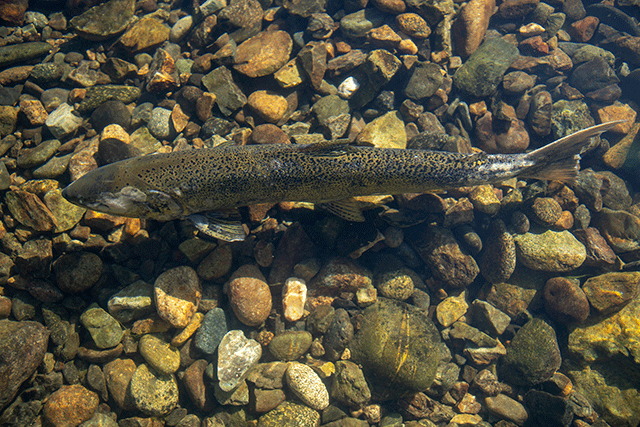
In a recent study published in the journal Science, HSU Fisheries Biology Professor Andrew Kinziger, HSU graduate student James Hearsey, and their colleagues from NOAA, UC Santa Cruz, and Colorado State University compared billions of DNA bases, the DNA building blocks (e.g., A, T, C, and G), in spring and fall Chinook salmon to see where they differed. To their surprise, they found a minute variation between spring and fall salmon on chromosome 28, in a single small region, known as the Region of Strongest Association or RoSA, that determines when fish migrate upriver.
“Our result was extraordinary because we expected the genetic underpinnings to involve many genes, each with a small effect, but what we found was incredibly simple — a single small genomic region that determines whether the fish migrates in spring or fall,” says Kinziger. “It’s a total win for conservation.”
The findings provide strong evidence that spring and fall Chinook salmon are a single species, despite clear differences in run-timing, fat content, size, and spawning locations.
To expand their data set, the researchers partnered with the Yurok Tribe to analyze the genetics of a Chinook salmon fishery in the Klamath River estuary. They found that the RoSA could be used to almost perfectly predict the date Chinook salmon enter the Klamath River, with a cut-off date of about August 1. The research highlights the strong role of genetics.
Each Chinook salmon inherits two genetic variants (or alleles) from their parents. Chinook salmon that possess two copies of the early allele (EE homozygous) all enter the Klamath River before August 1, whereas those with two copies of the late allele (LL homozygous) enter after this date. Individuals that are a mix of both genotypes (EL heterozygous) had intermediate migration times. It follows that if two heterozygous parents were to mate their offspring would be a mixture of EE homozygous (spring), LL homozygous (fall), and EL heterozygous individuals.
“Just like in humans, where brothers and sisters can have different colored eyes, a pair of Chinook salmon parents could produce offspring that are a mixture of spring and fall fish,” explains Kinziger.
The research has put a spotlight on the importance of migration run timing as the key trait that defines spring and fall salmon. The data from the study shows that the RoSA genotype explains 85% of the variation in salmon migration patterns.
Kinziger explains that the study’s findings could have a profound impact on future conservation projects to restore salmon runs on the Klamath River.
Chinook salmon are currently divided into 17 groups for conservation; nine of these are listed as threatened or endangered under the Endangered Species Act. The Klamath River is home to one of the largest Chinook salmon runs on the west coast and supports important commercial, recreational, and tribal fisheries.
Over the past 100-150 years, Chinook salmon runs on the Klamath have declined precipitously due the construction of dams, overfishing, and habitat degradation. Spring Chinook salmon have been the hardest hit—the upper Klamath River population is extinct, and the number of adults returning to wild areas in other parts of the Klamath River is estimated at 100s-1000s fish, with additional supplementation from hatcheries.
But Kinziger explains that their recent study indicates that spring-run Chinook salmon are potentially less threatened than scientists had thought. By surveying thousands of Chinook salmon from northern California and southern Oregon, the researchers found that the early allele was widespread in salmon populations with suitable habitat.
An important repository of the early allele in the Klamath Basin is the Trinity River Hatchery, which releases millions of spring Chinook salmon every year. “Over time, hatcheries have come to be seen in a negative light, however, in this case the Trinity River Hatchery appears to have played a role in retaining the early allele in the Klamath-Trinity Basin,” says HSU Professor Emeritus David Hankin, who has worked on salmonid management for over 35 years. “I think we can chalk that up as a positive impact of hatchery operations.”
The study also reframes the outlook for restoring spring-run salmon to the upper Klamath River where four impassable dams are slated for removal—one of the largest habitat restoration efforts in history. Among the many groups who have advocated to let the Klamath River run wild again, the Yurok Tribe stands to see their way of life restored with the return of native salmon runs.
A big question remains in how to bring back spring salmon to the upper Klamath River, once the dams are removed. The new research may provide guidance, explains Kinziger.
The researchers found that the descendants of extirpated Klamath River spring Chinook salmon are still present, suggesting that a historically accurate replica of the spring-run might be regenerated in the Klamath. Once suitable habitat exists in the upper Klamath, the researchers believe that the early allele can repopulate naturally; alternatively, fisheries management programs could jumpstart the process with help from hatcheries by stocking fish with the early allele in the upper Klamath population.
“Our findings provide a new perspective and offer paths for achieving this incredibly important goal that means so much, environmentally and culturally, to the North Coast,” says Kinziger.